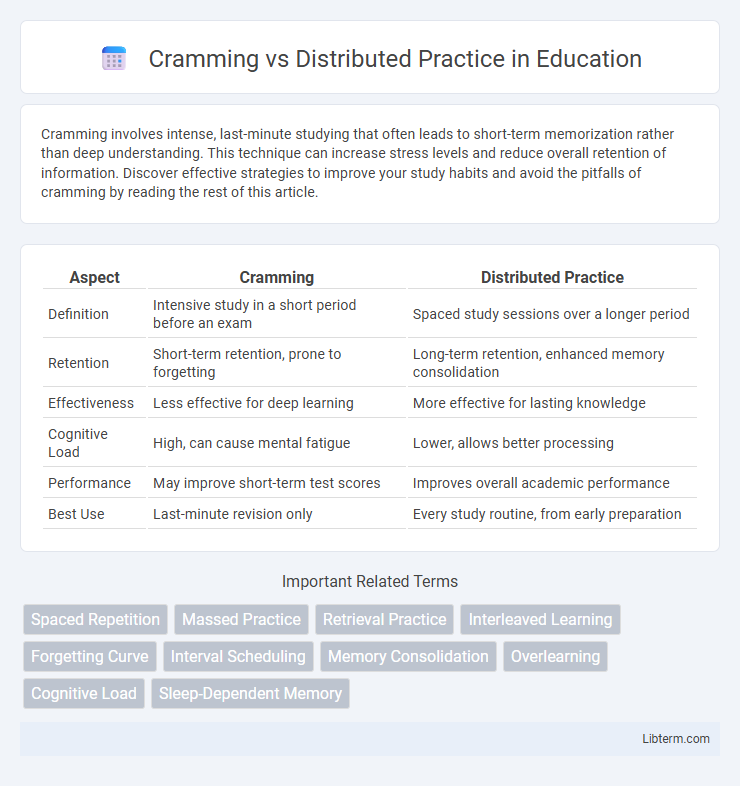Cramming involves intense, last-minute studying that often leads to short-term memorization rather than deep understanding. This technique can increase stress levels and reduce overall retention of information. Discover effective strategies to improve your study habits and avoid the pitfalls of cramming by reading the rest of this article.
Table of Comparison
| Aspect | Cramming | Distributed Practice |
|---|---|---|
| Definition | Intensive study in a short period before an exam | Spaced study sessions over a longer period |
| Retention | Short-term retention, prone to forgetting | Long-term retention, enhanced memory consolidation |
| Effectiveness | Less effective for deep learning | More effective for lasting knowledge |
| Cognitive Load | High, can cause mental fatigue | Lower, allows better processing |
| Performance | May improve short-term test scores | Improves overall academic performance |
| Best Use | Last-minute revision only | Every study routine, from early preparation |
Understanding Cramming: Definition and Methods
Cramming involves intensive, short-term study sessions aimed at memorizing large amounts of information quickly, often before exams. Common methods include repetitive reading, keyword mnemonics, and last-minute review of notes without deep processing. This approach prioritizes immediate recall but typically results in lower long-term retention compared to distributed practice strategies.
What Is Distributed Practice? An Overview
Distributed practice, also known as spaced repetition, involves spreading study sessions over time to enhance long-term retention and mastery of material. Unlike cramming, which condenses learning into a short period, distributed practice leverages intervals between sessions to strengthen memory consolidation and retrieval. Research in cognitive psychology consistently shows that distributed practice improves academic performance and reduces cognitive overload compared to massed learning techniques.
The Science Behind Memory Retention
Memory retention significantly improves through distributed practice, leveraging the spacing effect, which allows the brain to consolidate information over time and form stronger neural connections. Cramming overwhelms short-term memory and limits the brain's ability to transfer knowledge into long-term storage, causing rapid forgetting. Neuroscientific studies reveal that repeated retrieval and spaced repetition enhance synaptic plasticity, making distributed practice more effective for durable learning outcomes.
Cognitive Effects: Cramming vs Distributed Practice
Cramming leads to rapid short-term memory retention but often results in poor long-term recall and increased cognitive fatigue. Distributed practice enhances neural connections through spaced repetition, improving long-term retention and reducing mental overload. Cognitive effects favor distributed practice as it supports deeper learning and memory consolidation compared to cramming's shallow processing.
Academic Performance: Which Method Wins?
Distributed practice consistently outperforms cramming in enhancing academic performance by promoting long-term retention and deeper understanding of material. Cramming may yield short-term benefits but often leads to cognitive overload and rapid forgetting, undermining exam success and knowledge application. Research from cognitive psychology highlights distributed practice as the superior learning strategy for sustained academic achievement.
Stress and Mental Health Implications
Cramming increases acute stress levels and impairs long-term retention, often leading to anxiety and burnout due to intense last-minute studying. Distributed practice reduces cognitive overload by spacing learning sessions, promoting better memory consolidation and lowering stress responses. This approach supports mental health by fostering a balanced study routine, improving both academic performance and psychological well-being.
Time Management Strategies for Effective Study
Distributed practice enhances retention by spacing study sessions over time, reducing cognitive overload compared to cramming's massed sessions. Effective time management strategies involve scheduling regular, shorter study intervals aligned with peak cognitive functioning to leverage the spacing effect. Utilizing tools like planners or digital calendars supports the consistent implementation of distributed practice, optimizing long-term memory consolidation and academic performance.
Long-Term vs Short-Term Learning Outcomes
Cramming often leads to short-term memorization but poor retention and recall over time, making it ineffective for long-term learning outcomes. Distributed practice, also known as spaced repetition, enhances memory consolidation by spacing study sessions, resulting in stronger and more durable learning. Research consistently shows that distributed practice improves long-term retention and application of knowledge, whereas cramming primarily benefits immediate test performance.
Practical Tips to Shift from Cramming to Distributed Practice
To shift from cramming to distributed practice, start by creating a study schedule that breaks material into smaller, manageable chunks spaced over days or weeks. Utilize tools like flashcards and self-quizzing to reinforce learning during these intervals, ensuring better retention and understanding. Setting consistent daily study times and using apps like Anki or Quizlet can help maintain regular review sessions and reduce last-minute cramming.
Expert Recommendations and Final Thoughts
Expert recommendations emphasize distributed practice as a highly effective learning strategy, promoting retention and deeper understanding over time. Research consistently shows that spacing study sessions leads to better long-term memory consolidation compared to cramming, which often results in short-term gains but rapid forgetting. Incorporating distributed practice into study routines supports sustainable academic success and improved cognitive performance.
Cramming Infographic

 libterm.com
libterm.com